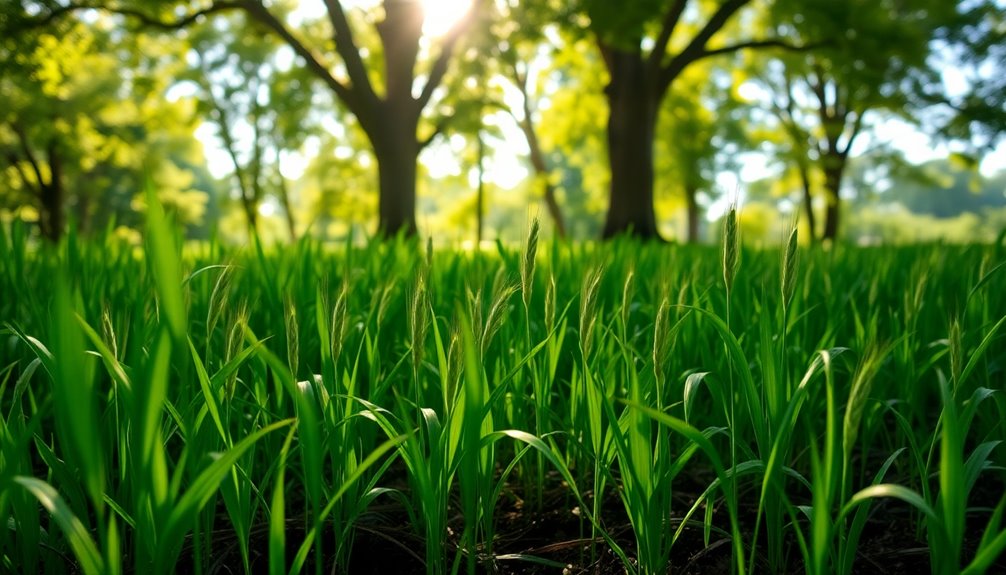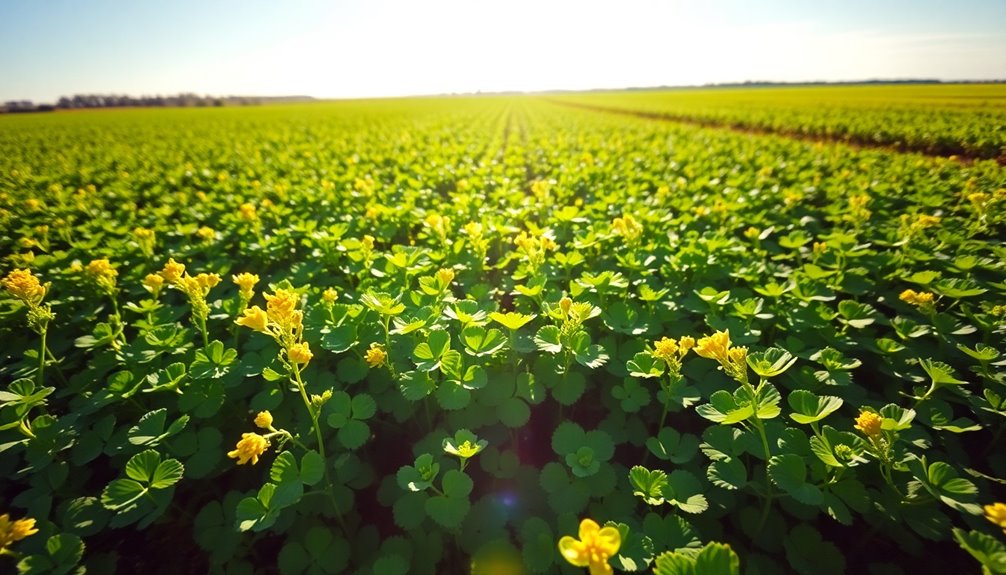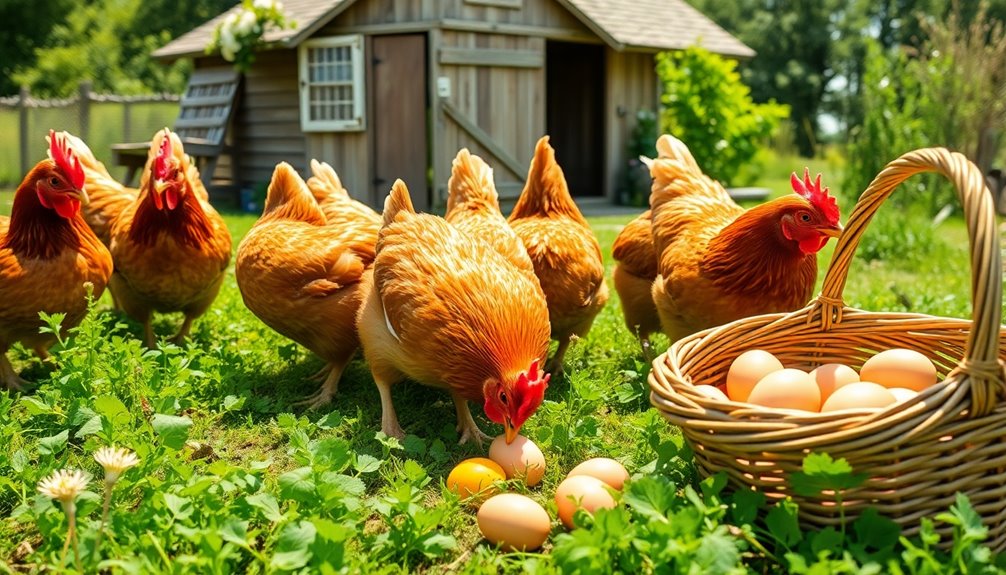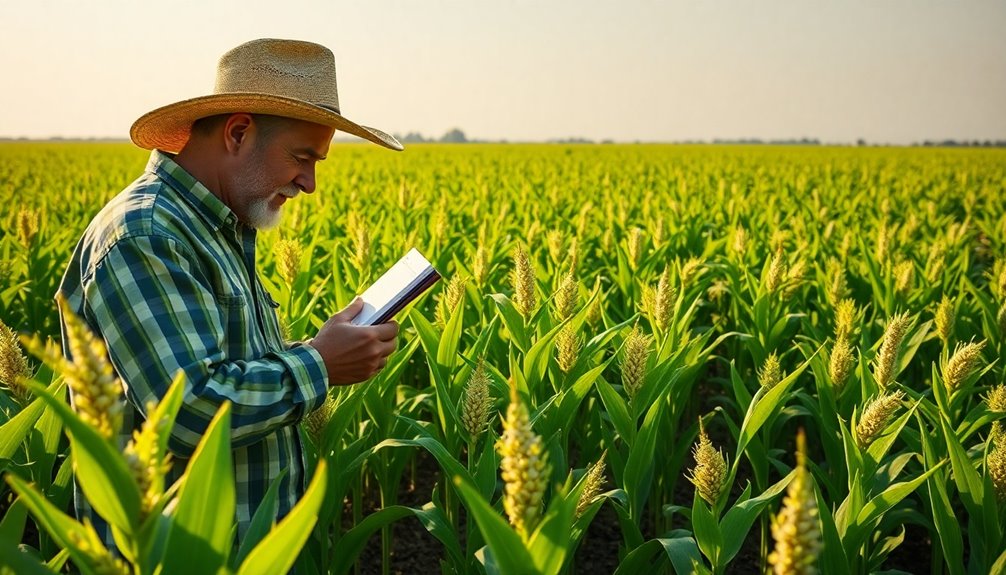Yes, forage oats can grow in shade, demonstrating impressive resilience. These oats, particularly Buck Forage Oats, do well in partially shaded areas, needing at least four hours of sunlight daily. To enhance growth, plant them in late summer to mid-fall, before dense foliage sets in. Pay attention to soil nutrients, as rich soil enhances their performance in low light. Mixing them with other shade-tolerant species also boosts overall growth. Plus, they attract wildlife, making them a great choice for enhancing your land's ecosystem. Stick around to uncover more about their benefits and ideal growing strategies!
Key Takeaways
- Buck Forage Oats can grow in partially shaded areas, requiring at least four hours of direct sunlight daily for optimal growth.
- Soil nutrient levels significantly impact the success of forage oats in shaded environments, making soil testing essential before planting.
- For best results, plant Buck Forage Oats in late summer to mid-fall, prior to leaf drop, to maximize sunlight exposure.
- Mixing forage oats with other shade-tolerant species can enhance overall growth, nutrient availability, and resilience in low-light conditions.
- Buck Forage Oats are highly palatable, attracting wildlife like deer, making them beneficial for enhancing hunting grounds in shaded areas.
Understanding Shade Tolerance
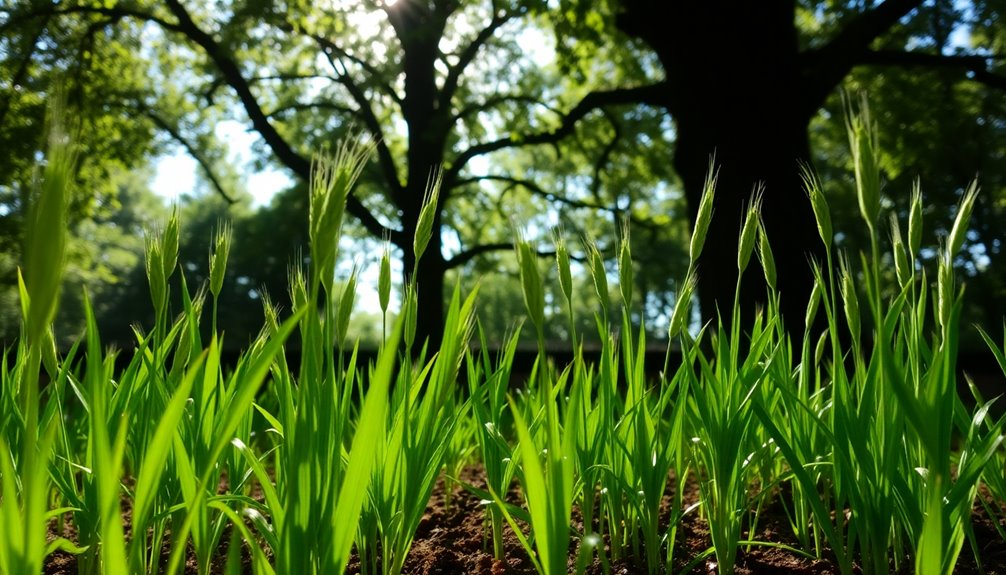
When it comes to understanding shade tolerance in forage oats, it's essential to recognize that these plants can thrive in partially shaded areas, particularly Buck Forage Oats. These oats exhibit a level of shade tolerance, making them an excellent choice for your food plot if you've got broken canopies rather than dense tree cover.
They can grow well with at least four hours of direct sunlight daily, allowing them to flourish in environments where light is limited. Their adaptability extends beyond light conditions; Buck Forage Oats can perform well in a variety of soil types, even those with lower nutrient levels. This adaptability is crucial for camping locations that may have varying soil quality due to shade from nearby trees or structures.
This feature becomes especially beneficial in shaded areas where soil quality might be compromised. You'll find that their germination rates are generally quick, enabling you to take advantage of early forage opportunities in shaded plots. Additionally, their growth can support local ecosystems and enhance biodiversity and ecosystem health, providing a sustainable food source for various wildlife.
For even better results, consider mixing forage oats with other shade-tolerant species like Winter Rye or clovers. This combination enhances overall growth and resilience in low-light conditions, ensuring your food plot remains productive and sustainable throughout the growing season.
Sunlight Requirements for Forage
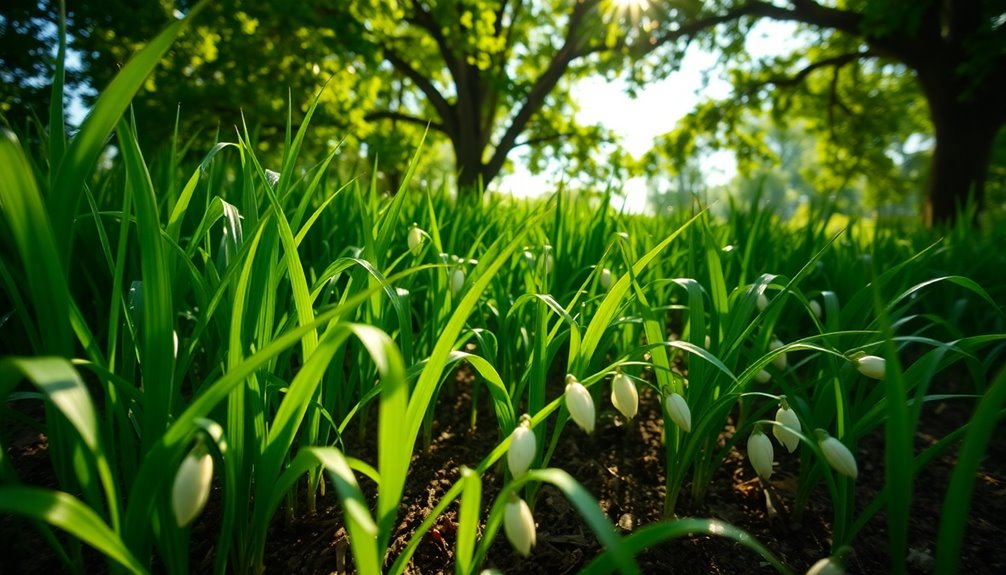
Forage oats thrive best with a solid balance of sunlight and shade, needing at least four hours of direct sunlight daily for ideal growth.
While they generally require about half a day of sunlight for peak development, they can tolerate some shaded areas, particularly if you plant them before leaf fall. This adaptability makes forage oats a versatile choice for various locations.
Buck Forage Oats stand out for their ability to flourish in shaded environments, allowing you to grow them even where sunlight is limited.
If you're considering planting in shaded areas, remember that seeding in the fall before canopy cover becomes dense can enhance their performance.
Most forage crops, including oats, rely on sufficient sunlight to guarantee adequate photosynthesis and energy production.
However, keep in mind that the effectiveness of forage oats in shaded areas can vary based on local conditions, such as tree density and soil nutrient availability. Additionally, ensuring sufficient sunlight is crucial for maximizing their growth potential.
Soil Nutrient Considerations
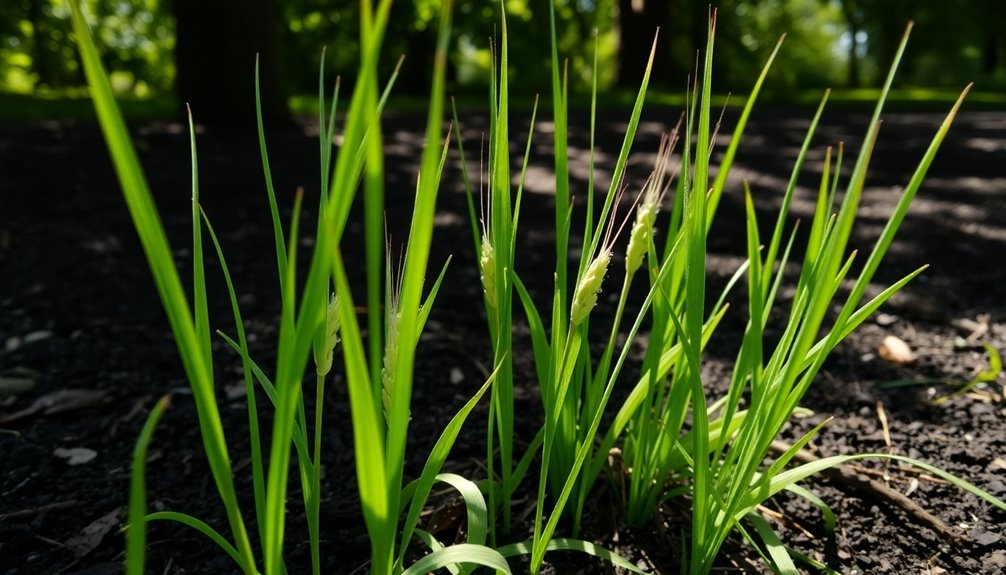
Soil nutrient levels play an essential role in the success of forage oats, especially in shaded environments. To guarantee your forage oats thrive, conducting soil testing is fundamental. This process helps you determine nutrient levels and pH balance, which directly influences growth.
In shaded areas, nutrient-rich soil is imperative; it enhances resilience and productivity, allowing the oats to adapt to less-than-ideal light conditions.
If your soil tests reveal deficiencies, don't hesitate to implement fertilization strategies to correct these issues. Providing essential nutrients like nitrogen, phosphorus, and potassium can greatly boost the health of your forage oats.
Healthy soil also supports better moisture retention, which is crucial when light conditions may limit growth.
Additionally, consider incorporating diverse blends of forages into your planting strategy. This approach can improve overall soil health and nutrient availability, benefiting the growth of forage oats in shaded plots.
Best Forage Options for Shade
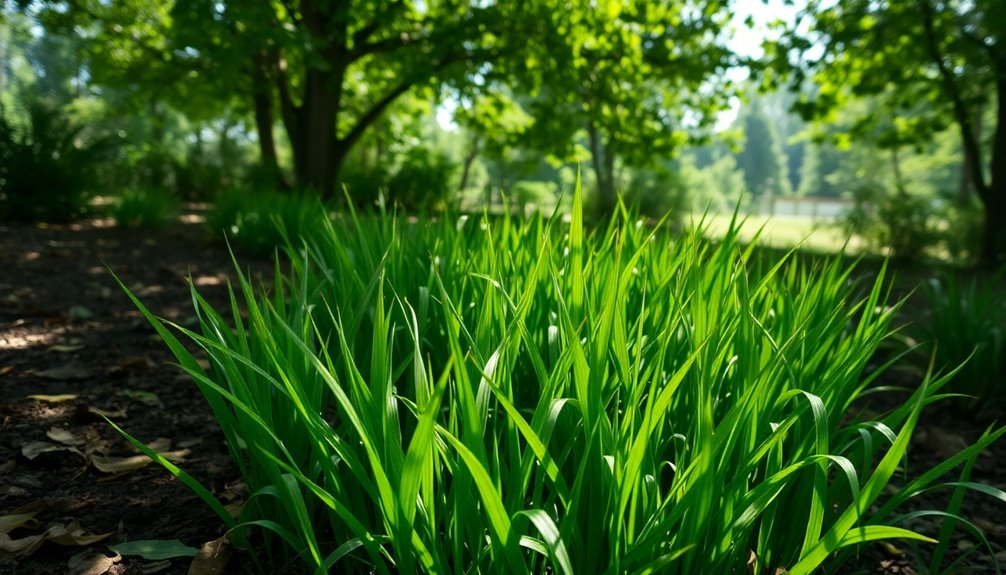
When it comes to finding the best forage options for shaded areas, you'll want to focus on shade-tolerant crop varieties. Buck Forage Oats, White Dutch Clover, and Chicory stand out as top choices that thrive in low light. Additionally, understanding zoning laws can help ensure that your shaded plots comply with local regulations regarding crop cultivation. Using effective planting techniques can help you maximize growth potential and guarantee a healthy yield in your shaded plots. Moreover, incorporating eco-friendly practices in your farming methods can further enhance the resilience and sustainability of these crops. Additionally, establishing a foundation of essential training methods can further enhance your success in growing these crops.
Shade-Tolerant Crop Varieties
In shaded areas of your pasture or garden, selecting the right crop varieties can make all the difference in achieving a productive forage system. Shade-tolerant options are essential for thriving in low-light conditions, and several varieties stand out for their resilience and adaptability.
Consider these best forage options for shady areas:
- Buck Forage Oats: Specifically recommended for extremely shady locations, they flourish in low-light conditions.
- White Dutch Clover: Thrives with at least 4 hours of direct sunlight daily, making it a great addition to mixed forage plots.
- Cereal Rye: Ideal for fall planting before leaf drop, this crop adapts well to varying light conditions and grows effectively in shaded areas.
- Alsike Clover: Known for good shade resilience, it adapts to various soil types, enhancing your forage diversity.
Incorporating these shade-tolerant varieties not only maximizes your forage potential but also helps maintain soil health and supports local wildlife.
Optimal Planting Techniques
To achieve the best results with forage oats in shaded areas, using ideal planting techniques is vital. Start by choosing Buck Forage Oats, as they're particularly well-suited for low-light conditions. For best establishment, plant them in the fall, well before leaf fall. This timing helps enhance their growth potential and allows them to thrive in cooler temperatures. Additionally, employing advanced technology can help monitor and optimize growth conditions for your crops.
Mixing your oats with other shade-tolerant species, like Winter Rye and Alsike Clover, can greatly boost overall growth and nutrient availability. This combination not only supports your oats but also enriches the soil, creating a healthier environment for all plants.
Before planting, conduct a soil test to identify any nutrient deficiencies. By knowing what your soil lacks, you can make the right amendments to guarantee your forage oats have the nutrients they need to flourish in shaded environments. Additionally, understanding the importance of sustainable harvesting practices can help ensure that your foraging efforts do not negatively impact the surrounding ecosystem.
Regular maintenance is also essential. Monitor moisture levels and control weeds to maximize the success of your oats and other forages.
Planting Techniques for Success
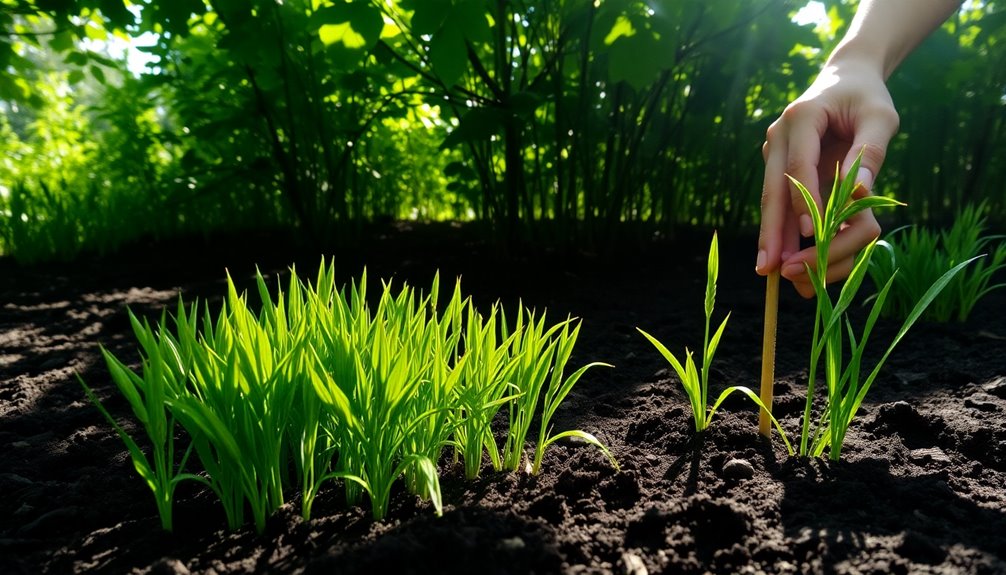
To set yourself up for success with Buck Forage Oats, timing your planting is key; aim for the fall before leaves drop.
Make sure to plant your seeds at a depth of 1-1.5 inches to help them reach the moisture they need in shaded areas.
Optimal Planting Timing
Timing your planting of Buck Forage Oats plays an essential role in achieving ideal results, especially in shaded areas. For peak planting timing, you want to aim for late summer to mid-fall. This approach allows the oats to establish themselves before winter, guaranteeing they're ready for grazing by mid-to-late fall.
Planting before leaf drop maximizes sunlight exposure, which is critical in shaded environments.
Consider these key points for successful planting:
- Establish Early: Plant in the fall to give your forage oats a head start.
- Depth Matters: While we'll cover that next, remember that the right depth is necessary for moisture access.
- Mixed Planting: Incorporate other species like winter rye to enhance light utilization and promote growth.
- Regular Maintenance: Monitor soil moisture and control weeds to guarantee your oats thrive.
Seed Depth Considerations
Achieving successful germination of forage oats in shaded environments hinges on the right seed depth. For ideal results, you should plant your seeds at a depth of 1 to 1.5 inches. This depth guarantees the seeds have adequate access to moisture, which is essential for germination, especially in shaded areas where evaporation rates are lower.
If you plant too shallow, your seeds risk exposure to harsh conditions, making it difficult for them to thrive. Conversely, planting too deep can hinder the seeds from reaching the surface for sunlight, which is crucial for their growth.
In shaded locations, maintaining consistent soil moisture during the germination phase is important. A proper seed depth helps retain moisture, creating a favorable environment for the seeds to establish themselves.
Don't forget to monitor your soil conditions and adjust the seed depth as needed. This simple practice can greatly influence the success of your forage oats, leading to healthier growth and improved forage availability.
Wildlife Attraction and Benefits
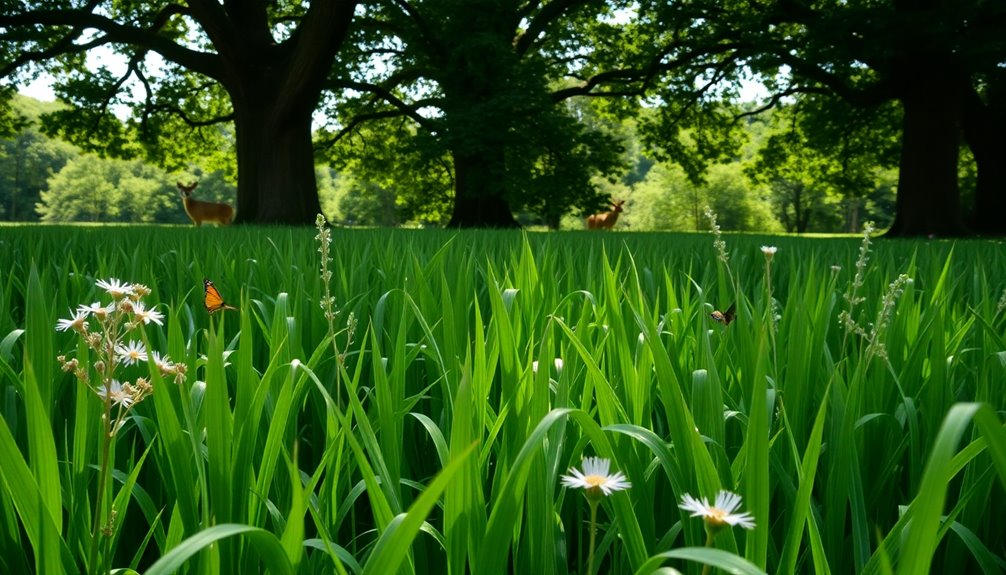
Forage oats, especially Buck Forage Oats, are a game-changer when it comes to attracting wildlife, particularly deer. Their high palatability and nutritional content make them irresistible, providing essential sugars, carbohydrates, and protein that deer crave.
As you observe your planted areas, you'll likely notice wildlife activity indicated by tracks and nipped tops of the forage oats, showcasing their appeal.
Planting forage oats in shaded environments can greatly enhance deer visitation, making them an excellent choice for food plots in forested areas.
Here are some benefits of using forage oats:
- Nutritional Value: High in essential nutrients, promoting deer health.
- Versatility: Thrive in partial shade, ideal for various landscapes.
- Increased Wildlife Activity: Attracts not only deer but other wildlife as well.
- Hunting Benefits: Enhances hunting grounds by drawing deer closer to your location.
Success stories from landowners confirm that strategically planting these forage oats in shaded logging roads or clearings leads to increased wildlife attraction and improved hunting experiences.
Frequently Asked Questions
Will Oats Grow in the Shade?
Yes, oats can grow in the shade, but they need some sunlight to thrive. Ideally, they require around 4 to 6 hours of sunlight daily.
If you plant them in partial shade, particularly in nutrient-rich soil, you might see decent growth. However, keep in mind that deep shade can hinder their performance compared to other forage crops.
Mixing oats with shade-tolerant forages like Winter Rye can improve your chances of success.
Do Buck Forage Oats Need Full Sun?
Buck Forage Oats don't need full sun to thrive; in fact, they can flourish in partial shade, enjoying 4-6 hours of sunlight daily.
You'll find they adapt well to cooler climates and shorter growing seasons, making them a great choice for northern regions.
By mixing them with other shade-tolerant crops, you'll boost their growth.
What Is the Best Shade Tolerant Food Plot Seed?
When you're looking for the best shade-tolerant food plot seed, consider Buck Forage Oats, Cereal Rye, and Alsike Clover.
These options adapt well to low-light conditions, ensuring your plot thrives even in shaded areas.
White Dutch Clover can enhance your mix, boosting overall success. Chicory is another great choice, providing perennial nutrition.
What Is the Difference Between Oats and Forage Oats?
Imagine a lush field, where traditional oats stand tall, waiting for harvest, while forage oats flourish with a purpose—to nourish livestock.
The difference lies in their intent: traditional oats are grown for grain, while forage oats provide high-quality feed.
You'll find forage oats packed with protein, ideal for grazing animals, and they're often sown as an annual crop.
This makes them a quick source of sustenance, especially in fall and winter.
Conclusion
So, can forage oats really thrive in the shade? The truth might surprise you! While they prefer full sun, they can tolerate some shade, especially if you choose the right planting techniques and soil nutrients. If you're looking to maximize your yield in less-than-ideal conditions, experimenting with forage oats could be your key to success. Plus, you'll attract wildlife while doing it! Don't underestimate the resilience of this crop—it just might outperform your expectations!

